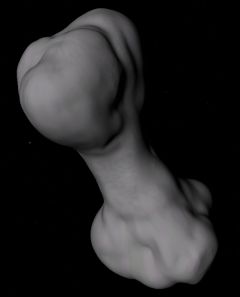216 Kleopatra
Jump to navigation
Jump to search
| 216 Kleopatra | |
|---|---|

| |
| 216 Kleopatra from Asteroid 3D.zip in Orbiter 2016 with D3D9 | |
| Designation | |
| Name | 216 Kleopatra |
| Reference body | Sun |
| Planetary mean orbits | |
| Epoch | 2006 |
| Semimajor axis (a) | 417984360287.592 m |
| Eccentricity (e) | 0.25156771162119 |
| Inclination (i) | 13.13670991° (0.229278840724192 radian) |
| Longitude of the ascending node (LAN, ☊) | 215.6635692° (3.76403935984912 radian) |
| Longitude of periapsis (ϖ) | 384.8684456° (6.89175448860117 radian) |
| Mean longitude (L) | 520.9843206° (9.09289174498727 radian) |
| Selected physical parameters | |
| Mean radius | 15670 km |
| Mass | 1.989×1018 kg |
| Rotation elements | |
| SidRotPeriod | 19386 seconds (5.385 hours) |
| SidRotOffset | 0 |
| Obliqutiy | 0 |
| LAN | 0 |
| Note | *Elements given are from Kleopatra.cfg (Asteroid 3D.zip) |
216 Kleopatra is a large asteroid shape sorta like a dumbbell. It was discovered by Johann Palisa on 10 April 1880 and was named for Cleopatra.
216 Kleopatra in Orbiter
216 Kleopatra was first introduced with the release of MainBeltAsteroids051403.zip in May 2003.
Note that the landing surface as given in the config file is spherical, but the visual of these bodies are not, if you land, you will likely be above or below the visual surface.
| Add-on | Source | Version | Author | Type | Release Date | Compatibility | Wiki article |
|---|---|---|---|---|---|---|---|
| 3D Asteroids | O-F Resources | 2014-11-06 | T1234 | Scenery | 6 November 2014 | ||
| Asteroid Pack 1.00 | O-F Resources | 2004-11-21 | Nighthawke | Scenery | 21 November 2004 | ||
| Main Belt Asteroids v1.0 | O-F Resources | v1.0 | Unknown OHM Addon Developer | Scenery | 14 May 2003 | ||
See also
Gallery
| edit The Solar System | |
|---|---|
| Central star |
Sun (Sol) |
| Planets |
Mercury - Venus - Earth - Mars - Jupiter - Saturn - Uranus - Neptune |
| Natural satellites |
Moon - Phobos - Deimos - Io - Europa - Ganymede - Titan - more... |
| Add-ons |
Planets - Dwarf Planets - Small objects - Natural satellites - Alternative star systems |





